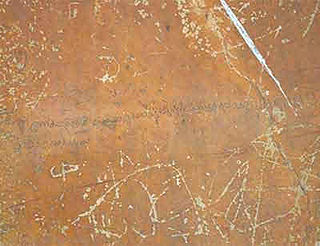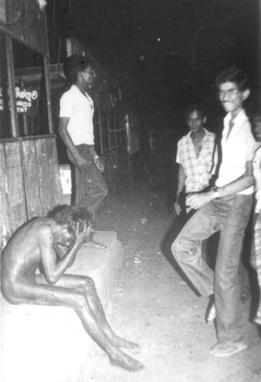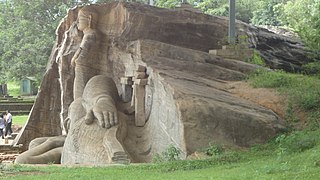
The Sinhala script, also known as Sinhalese script, is a writing system used by the Sinhalese people and most Sri Lankans in Sri Lanka and elsewhere to write the Sinhala language as well as the liturgical languages Pali and Sanskrit. The Sinhalese Akṣara Mālāva, one of the Brahmic scripts, is a descendant of the Ancient Indian Brahmi script. It is also related to the Grantha script.

Sinhala, sometimes called Sinhalese, is an Indo-Aryan language primarily spoken by the Sinhalese people of Sri Lanka, who make up the largest ethnic group on the island, numbering about 16 million. Sinhala is also spoken as the first language by other ethnic groups in Sri Lanka, totalling about 2 million speakers as of 2001. It is written using the Sinhala script, which is a Brahmic script closely related to the Grantha script of South India.

Anagārika Dharmapāla was a Sri Lankan Buddhist revivalist and a writer.
Sri Lanka, officially the Democratic Socialist Republic of Sri Lanka, is an island country in the northern Indian Ocean which has been known under various names over time.

Black July was an anti-Tamil pogrom that occurred in Sri Lanka during July 1983. The pogrom was premeditated, and was finally triggered by a deadly ambush on 23 July 1983, which caused the death of 13 Sri Lanka Army soldiers, by the Tamil militant group Liberation Tigers of Tamil Eelam (LTTE). Although initially orchestrated by members of the ruling UNP, the pogrom soon escalated into mass violence with significant public participation.
Bharatha People also known as Bharatakula and Paravar, is an ethnicity in the island of Sri Lanka. Earlier considered a caste of the Sri Lankan Tamils, they got classified as separate ethnic group in the 2001 census. They are descendant of Tamil speaking Paravar of Southern India who migrated to Sri Lanka under Portuguese rule. They live mainly on the western coast of Sri Lanka and mainly found in the cities of Mannar, Negombo and Colombo.

The Gal Vihara, and known originally as the Uttararama, is a rock temple of the Buddha situated in the ancient city Polonnaruwa, the capital of the ancient Kingdom of Polonnaruwa, now present-day Polonnaruwa, in North Central Province, Sri Lanka. It was fashioned in the 12th century by King Parakramabahu I. The central feature of the temple is four rock relief statues of the Buddha, which have been carved into the face of a large granite gneiss rock. The images consist of a large seated figure, another smaller seated figure inside an artificial cavern, a standing figure, and a reclining figure. These are considered to be some of the best examples of ancient Sinhalese sculpting and carving arts, and have made the Gal Vihara the most visited monument at Polonnaruwa.

Wijayatunga Mudalige Harischandra Wijayatunga is a Sri Lankan author, translator, lexicographer, teacher, lawyer and politician. He held various offices in different institutions of the Government of Sri Lanka. At present he is the leader of Sinhalaye Mahasammatha Bhoomiputra Party. During the presidential elections of 1994 and 1999, he was the candidate of that party for this high office.
Kandarodai is a small hamlet and archaeological site of Chunnakam town, a suburb in Jaffna District, Sri Lanka. The notable ancient Buddhist monastery referred to as Kadurugoda Vihara is situated in Kandarodai.

Ja-Ela is a town, located approximately 20 km (12 mi) north of the city centre of Colombo, Sri Lanka. Ja-Ela lies on the A3 road which overlaps with the Colombo – Katunayake Expressway at the Ja-Ela Interchange.

The Anuradhapura period was a period in the history of Sri Lanka of the Anuradhapura Kingdom from 377 BCE to 1017 CE. The period begins when Pandukabhaya, King of Upatissa Nuwara moved the administration to Anuradhapura, becoming the kingdom's first monarch. Anuradhapura is heralded as an ancient cosmopolitan citadel with diverse populations.

Ridi Viharaya or Silver Temple is a 2nd-century BCE Theravada Buddhist temple in the village of Ridigama, Sri Lanka. Built during the reign of Dutthagamani of Anuradhapura, the temple is considered as the place where the silver ore, which provided silver to complete Ruwanwelisaya; one of the largest stupa in Sri Lanka, was discovered. According to the chronicles Mahavamsa and Thupavamsa, the Ridi Viharaya complex was built in gratitude for helping him cherish his dream of completing Ruwanwelisaya.

Dr. Pannadasa Gardiye Punchihewa, C.C.S is a Sri Lankan author and an international civil servant.

This is a bibliography of works on Sri Lanka.

Palansuriya Mohottalalage Dingiri Mahaththaya (Sinhala: පලන්සුරිය මොහොට්ටාලලාගේ ඩිංගිරි මහත්තයා, known as Sagara Palansuriya in later life, was a Sri Lankan poet, teacher and Member of Parliament.
Manikku Badaturuge Ariyapala was a Sri Lankan academic and former President of the Colombo Campus, University of Colombo.

Korawakgala, or koravakgal (wingstones), are stone balustrades, which are located on either side of the stairs/steps leading to the entrance or door of a religious building or structure. They form one of three distinct architectural features at the entrance of most Buddhist structures in Sri Lanka, being the sandakada pahana (moonstone), muragala (guardstones) and the korawakgala (wingstones).

Dosi is a traditional Sri Lankan confectionery, similar in nature to fruit preserves or candied fruit. The dish is prepared by boiling segmented fruit in sugar and allowing it to cool in order for the sugar to crystallise on both the surface and the inside of the fruit. Dosi are traditionally served as a snack, during the day or after a meal. It is a dish that is commonly served by Sri Lankan Malays as a part of traditional Eid al-Fitr celebrations, marking the end of Ramadan. It is also popular during weddings, religious festivals and other social functions and celebrations. Variations include the addition of cardamom and/or cinnamon and/or rose essence.













